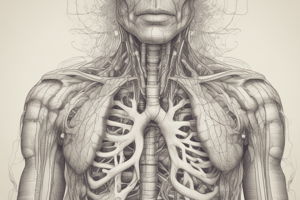Podcast
Questions and Answers
What is the primary function of the alveoli in the respiratory system?
What is the primary function of the alveoli in the respiratory system?
- To facilitate gas exchange between the air and the bloodstream. (correct)
- To regulate the temperature of the inhaled air.
- To transport oxygenated blood to the heart.
- To filter incoming air and remove foreign particles.
Which of the following conditions is characterized by a thickened respiratory membrane, leading to impaired gas exchange?
Which of the following conditions is characterized by a thickened respiratory membrane, leading to impaired gas exchange?
- Pulmonary Edema
- Asthma
- Emphysema
- Pneumonia (correct)
What is the primary difference between bronchitis and bronchiolitis?
What is the primary difference between bronchitis and bronchiolitis?
- Bronchitis is typically a milder illness than bronchiolitis.
- Bronchitis is primarily caused by bacteria, while bronchiolitis is primarily caused by viruses.
- Bronchitis is characterized by a dry cough, while bronchiolitis is characterized by a productive cough.
- Bronchitis affects the bronchi, while bronchiolitis affects the bronchioles. (correct)
Which of the following is NOT a common symptom associated with respiratory tract infections (RTIs)?
Which of the following is NOT a common symptom associated with respiratory tract infections (RTIs)?
What is the primary role of the diaphragm in ventilation?
What is the primary role of the diaphragm in ventilation?
Flashcards
Major Structures of Respiratory System
Major Structures of Respiratory System
Includes nasal cavity, pharynx, larynx, trachea, bronchi, and alveoli; each plays a role in airflow and gas exchange.
Process of Respiration
Process of Respiration
Involves inhalation, gas exchange in alveoli, and exhalation; oxygen is taken in and carbon dioxide is expelled.
Alterations in Respiratory Membrane
Alterations in Respiratory Membrane
Problems like pulmonary edema or fibrosis disrupt gas exchange, leading to reduced oxygen levels in blood.
Common Respiratory Tract Infections
Common Respiratory Tract Infections
Signup and view all the flashcards
Ventilation vs. Gas Exchange Disorders
Ventilation vs. Gas Exchange Disorders
Signup and view all the flashcards
Study Notes
Major Structures of the Respiratory System
- The respiratory system facilitates gas exchange, taking in oxygen and releasing carbon dioxide.
- The nose and nasal cavity filter, warm, and humidify inhaled air.
- The pharynx (throat) serves as a passageway for both air and food.
- The larynx (voice box) contains vocal cords and plays a role in sound production.
- The trachea (windpipe) is a rigid tube that carries air to the lungs.
- The bronchi are branches of the trachea that lead to the lungs.
- The bronchioles are smaller branches of the bronchi, further dividing into the terminal bronchioles.
- Alveoli are tiny air sacs in the lungs where gas exchange occurs. Alveoli are surrounded by capillaries for efficient diffusion of gases.
- The lungs are the primary organs of respiration, responsible for gas exchange.
Process of Respiration
- Respiration is a complex process involving multiple steps, including:
- Ventilation: the movement of air into and out of the lungs.
- External respiration: gas exchange between the alveoli and the blood.
- Internal respiration: gas exchange between the blood and the body's tissues.
- Breathing involves the contraction and relaxation of the diaphragm and intercostal muscles, creating pressure changes that draw air in and out.
Clinical Examples of Respiratory Membrane Problems
- Problems with the respiratory membrane can lead to various issues.
- Pneumonia, pulmonary edema, and pulmonary embolism can impair gas exchange leading to hypoxia or respiratory distress. Asthma and cystic fibrosis can also impact effectiveness.
Common Respiratory Tract Infections
- Common respiratory tract infections include the common cold, influenza, bronchitis, and pneumonia.
- These infections often present with symptoms including fever, cough, sore throat, and runny nose.
- Differentiating these infections sometimes requires clinical evaluation and tests.
Ventilation and Gas Exchange Disorders
- Ventilation disorders affect the movement of air into and out of the lungs.
- Obstructive lung diseases (asthma, chronic bronchitis, and emphysema) hinder airflow, leading to difficulty breathing.
- Restrictive lung diseases (pulmonary fibrosis and pleurisy) limit lung expansion and decrease lung volume, impacting gas exchange.
- Gas exchange disorders can include respiratory acidosis and alkalosis which can cause electrolyte imbalances and nervous system complications. Further, conditions affecting the respiratory membrane, like pneumonia and pulmonary edema, impede efficient gas exchange.
Studying That Suits You
Use AI to generate personalized quizzes and flashcards to suit your learning preferences.




